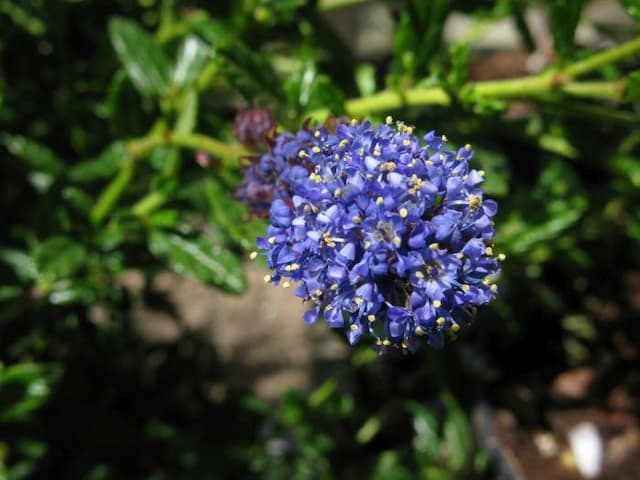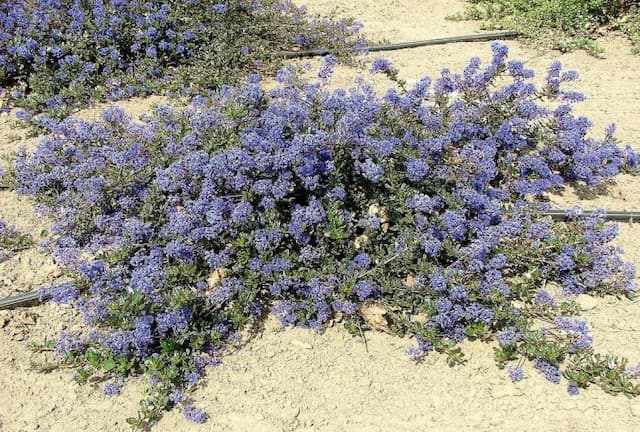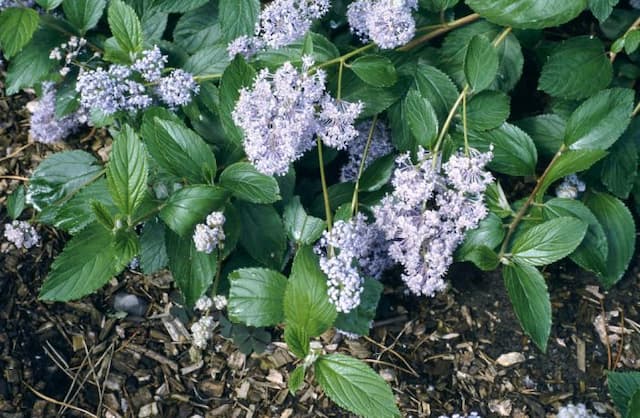Common Buckthorn Rhamnus cathartica






ABOUT
The common buckthorn, as it is widely known, is a deciduous shrub or small tree that is recognized by its dense, round to oval outline. Its leaves are simple, with finely toothed margins and a shiny, dark green color that turns yellow before falling in the autumn. The leaves are arranged suboppositely or alternately along the branches, creating a somewhat irregular pattern. In the spring, small greenish-yellow flowers emerge, which are modest and often go unnoticed. These flowers give way to the fruit, starting as green berries and maturing to a dark, purplish-black. The berries are quite small, with a somewhat glossy appearance. Its bark is gray-brown with light-colored lenticels that stand out in horizontal lines. The branches are fairly straight, with thorns that are sharp and stout. The overall form of the buckthorn can vary, often seen as dense and thicket-forming when untended, or more neatly shaped when cultivated or managed.
About this plant
 Names
NamesSynonyms
Common Buckthorn, European Buckthorn, Purging Buckthorn, Buckthorn.
Common names
Frangula cathartica, Rhamnus catharticus.
 Toxicity
ToxicityTo humans
Common buckthorn is considered toxic to humans. Consumption of the berries can cause severe diarrhea and abdominal pain due to the plant's laxative properties. The bark, leaves, and seeds also contain anthraquinones, which can have a laxative effect and potentially lead to dehydration and electrolyte imbalances if ingested in large quantities. It is generally advised to avoid consuming any part of the common buckthorn.
To pets
Common buckthorn is toxic to pets including dogs and cats. If ingested, the berries, leaves, or bark can cause gastrointestinal distress, notably vomiting and diarrhea, due to their cathartic effects. In large amounts, the toxins could lead to more serious symptoms, such as weakness, dehydration, or electrolyte imbalances. It is important to prevent pets from ingesting any part of the common buckthorn.
 Characteristics
CharacteristicsLife cycle
Perennials
Foliage type
Deciduous
Color of leaves
Green
Flower color
Greenish-yellow
Height
15-20 feet (4.6-6 meters)
Spread
10-15 feet (3-4.6 meters)
Plant type
Shrub
Hardiness zones
3
Native area
Europe
Benefits
 General Benefits
General Benefits- Habitat for Wildlife - Provides food and shelter for various bird species and small mammals.
- Erosion Control - Its extensive root system can help stabilize soil and prevent erosion.
- Hedging and Privacy - Can be used to create dense hedges for privacy screens in landscaping.
- Drought Resistance - Once established, it is quite tolerant of drought, reducing the need for watering.
- Low Maintenance - Requires little care once established, making it an easy plant for natural landscaping.
- Ornamental Berries - Produces small, dark berries that can add visual interest to gardens in the right context.
- Cold Hardy - Can survive in cold climates, which makes it suitable for a variety of landscapes.
- Pollinator Support - Flowers provide nectar and pollen for bees and other pollinating insects in spring.
 Medical Properties
Medical Properties- Laxative Effects: Historically, common buckthorn has been used for its laxative properties due to the presence of anthraquinones.
- Choleretic Action: The plant has been claimed to stimulate bile production, aiding in the digestion and detoxification processes.
- Purgative Qualities: It has also been used traditionally as a strong purgative to induce bowel movements.
 Air-purifying Qualities
Air-purifying QualitiesThis plant is not specifically known for air purifying qualities.
 Other Uses
Other Uses```html
- Ink Production: Rhamnus cathartica's berries can be used to make a natural greenish-yellow dye, which historically was used as ink.
- Woodturning: The dense wood of the common buckthorn is sometimes utilized in woodturning for making tool handles or small decorative items.
- Traditional Woodcraft: The wood of the common buckthorn can be used in making musical instruments, particularly woodwinds, due to its fine grain and hard nature.
- Printing Blocks: Because of its density and fine grain, common buckthorn's wood can be carved into blocks for printing purposes.
- Charcoal Production: The wood can also be burnt in a low oxygen environment to create artist's charcoal.
- Landscaping: Despite its invasive nature, common buckthorn is sometimes used as hedging or for privacy screens in landscaping, though this practice is discouraged in many areas.
- Wildlife Shelter: In some regions, the thickets formed by common buckthorn can provide shelter for wildlife, although its impact on biodiversity is often negative.
- Natural Barriers: The thorny nature and dense growth habit of common buckthorn can be utilized to create natural barriers against human and animal traffic.
- Fish Bait: The fruits of the common buckthorn have been used as bait for fishing, particularly for certain species of carp that are attracted to the berries.
- Historical Pigment: The yellowish dye extracted from the berries was occasionally employed as a pigment for painting or textile dyeing in historical contexts.
Interesting Facts
 Feng Shui
Feng ShuiBuckthorn is not used in Feng Shui practice.
 Zodiac Sign Compitability
Zodiac Sign CompitabilityBuckthorn is not used in astrology practice.
 Plant Symbolism
Plant Symbolism- Invasive Nature: Common Buckthorn (Rhamnus cathartica) is often associated with the symbolism of domination or takeover due to its invasive characteristics in non-native environments, where it spreads aggressively and outcompetes native vegetation.
- Healing: Historically, the berries of Common Buckthorn, though purgative, were used in small quantities for medicinal purposes. This gives the plant a symbolic association with healing and cleansing, despite its toxic nature in larger doses.
- Protection: Some cultures believed that thorny plants like the Common Buckthorn provided protection against evil spirits and negative energies. Its dense, thorny thickets could be seen as a symbol of a protective barrier.
 Water
WaterCommon Buckthorn (Rhamnus cathartica) requires moderate watering. During the growing season, it should be watered deeply once a week, ensuring that the soil is moist but not waterlogged. Provide approximately 1 to 1.5 gallons of water each time, allowing the top inch of soil to dry out between waterings. In the winter or during dormant periods, reduce the frequency to every other week or when the soil appears dry. Overwatering can lead to root rot, so it is essential to adjust the watering according to rainfall and seasonal temperature changes.
 Light
LightCommon Buckthorn thrives in full sun to partial shade. The best spot for this plant is one where it receives at least six hours of direct sunlight per day, although it can tolerate some afternoon shade. It is adaptable to different light conditions but will produce the most berries and have the healthiest growth when placed in an area with ample sunlight.
 Temperature
TemperatureCommon Buckthorn is adaptable to a wide range of temperatures but thrives best in conditions between 60°F and 70°F. It can survive minimum temperatures down to -30°F, making it hardy in very cold climates, and maximum temperatures up to 90°F without significant stress. However, extreme temperatures outside of the ideal range for prolonged periods may affect its growth and health.
 Pruning
PruningCommon Buckthorn benefits from pruning to control its growth and shape, as well as to remove any dead or diseased wood. The best time to prune is late winter or early spring before new growth starts. It should be pruned annually or as needed to maintain the desired form and remove any problematic branches. Since Common Buckthorn can be invasive, regular pruning can help prevent unwanted spreading.
 Cleaning
CleaningAs needed
 Soil
SoilCommon Buckthorn (Rhamnus cathartica) thrives in a well-draining soil mix with a pH range between 5.5 and 7.5. A mixture of garden soil, peat, and sand in equal parts is often recommended to ensure proper drainage and aeration. Regularly check the pH to maintain it within the optimum range for the health of the plant.
 Repotting
RepottingCommon Buckthorn (Rhamnus cathartica) doesn't require frequent repotting and can often thrive in the same pot for several years. Younger plants may be repotted every 2-3 years to encourage growth, but mature plants should be repotted less often, only when they become root-bound.
 Humidity & Misting
Humidity & MistingCommon Buckthorn (Rhamnus cathartica) is tolerant of a wide range of humidity levels and can thrive in the variable outdoor humidity found in its hardiness zones. It does not have specific humidity requirements and can adapt to both dry and humid environments.
 Suitable locations
Suitable locationsIndoor
Not ideal indoors due to size and invasive nature.
Outdoor
Plant in sun or part shade, moist, well-drained soil.
Hardiness zone
3-7 USDA
 Life cycle
Life cycleCommon Buckthorn (Rhamnus cathartica) typically begins its life cycle as a seed, dispersed by birds who eat the fruit and excrete the seeds away from the parent plant. Upon finding a suitable location, often in disturbed soil, the seed germinates in the spring, with the growth of a root (radicle) and a shoot that will develop into the stem. As a sapling, it undergoes a period of rapid growth, developing a woody stem and a branching canopy that supports leaves, photosynthesis, and further growth. After reaching maturity, which can take several years, it produces inconspicuous greenish-yellow flowers in clusters in late spring, which are pollinated by insects. The fertilized flowers develop into small, black, berry-like fruits by late summer, each containing seeds for dispersal. The process of flowering and fruiting occurs annually, with the plant able to live and reproduce for several decades if conditions are favorable.
 Propogation
PropogationPropogation time
Spring-Early Summer
The most popular method of propagating the common buckthorn (Rhamnus cathartica) is through seed collection and sowing. Seeds are generally collected in the fall after they have ripened, usually around September or October. The seeds have a tough outer coating, which can result in a prolonged germination time; to speed up the process, they can be stratified. This involves mixing the seeds with moist sand and storing them in a refrigerator at about 40 degrees Fahrenheit (4.4 degrees Celsius) for approximately 90 to 120 days. After stratification, the seeds can be sown in the spring either directly where they are to grow or in a nursery bed, where they can be looked after more carefully until they are ready to be transplanted to their final location.









